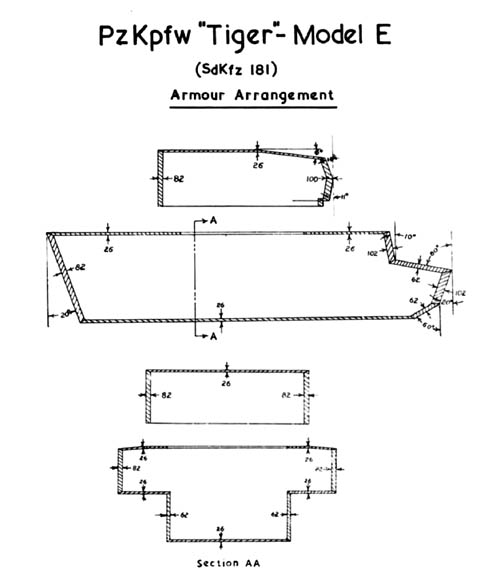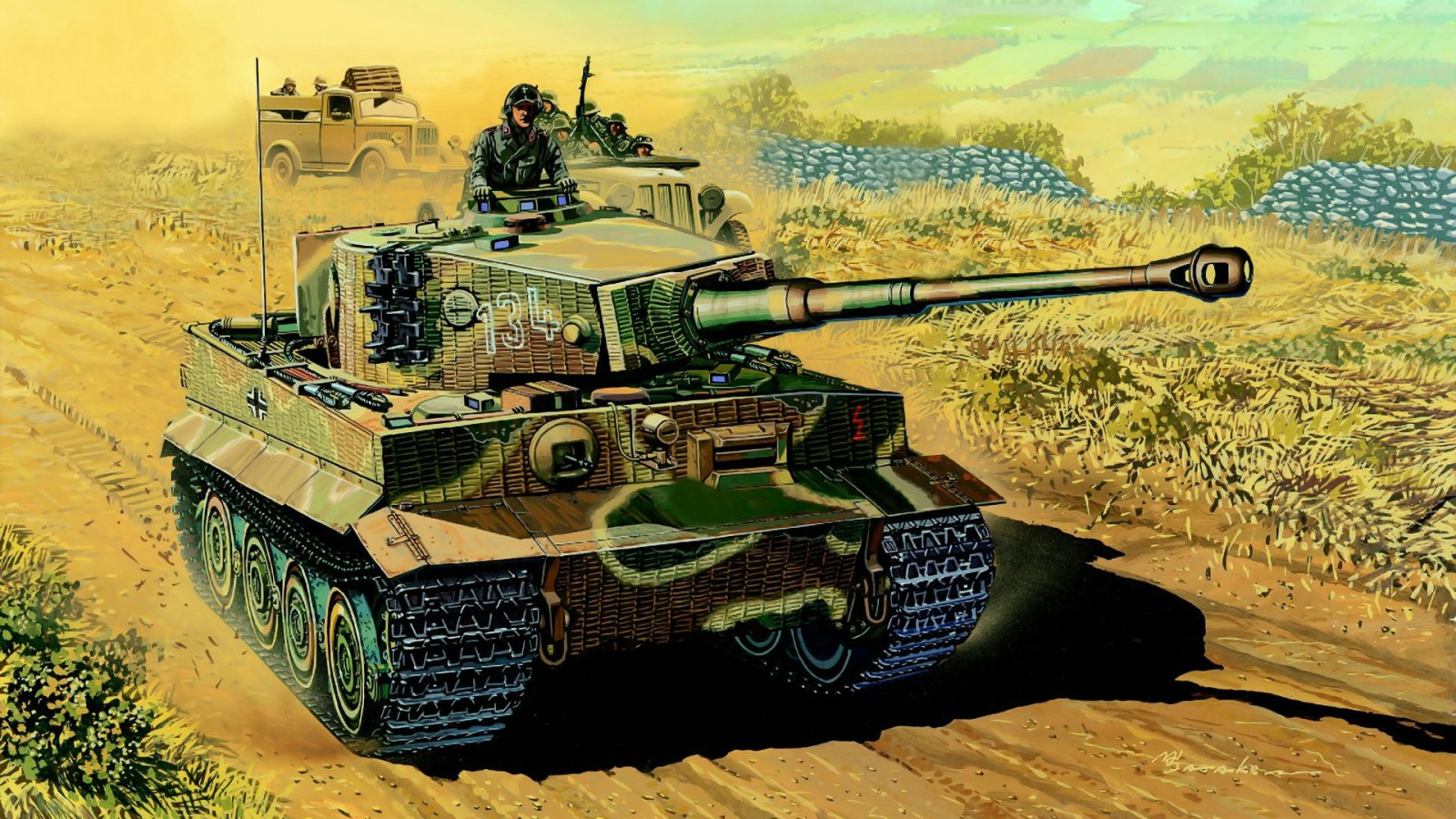Pzkpfw VI King Tiger II Armor Thickness Tiger, Tiger ii, King

According to The Chieftain, this means that the M4 Sherman's effective armor thickness is really 3.6 inches relative to a horizontal strike and is roughly comparable to the frontal armor on a Tiger I. Figure 4 shows how The Chieftain got his answer of 3.6 inches of effective armor thickness. The key formula here is .
Pin on Armored Vehicles

The Tiger I ( German: [ˈtiːɡɐ] ⓘ) was a German heavy tank of World War II that operated beginning in 1942 in Africa and in the Soviet Union, usually in independent heavy tank battalions.
Tiger's armour thickness on mantlet Germany tank, Tanks military

1. The first Tiger tank prototype was scheduled to be ready for Hitler's birthday on 20 April 1942 After Germany's invasion of the Soviet Union on 22 June 1941, they were shocked to encounter Soviet T-34 medium and KV-1 heavy tanks that were far superior to anything they had available.
Storm Tiger, Tiger I Cartoon Pics, Cartoon Styles, Tiger Tank, Tiger

The Tiger II was the successor to the Tiger I, combining the latter's thick armour with the armour sloping used on the Panther medium tank. The tank weighed almost 70 tonnes, and was protected by 100 to 185 mm (3.9 to 7.3 in) of armour to the front. [11]
World's only working Tiger Tank is put through its paces 75 years after

Panther tank vs Tiger tank - Key Points Historical Context: The Panther was developed as a response to the Soviet T-34, while the Tiger I was known for its. WWII showdown between the Panther tank vs Tiger tank, comparing their design, performance, and impact in a detailed and engaging analysis!.
Tank Archives Tigers in Tunisia

The frontal armor of the Tiger II provided the best protection possible - the front turret was 180 mm inclined at 10 degrees from the vertical, compounded with a special designed mantlet, which was immune to penetration and being jammed.. The thickness and angles of the armor protection are shown in the Table below :. The TIGER Tank.
tiger tank dimensions, Panzerkampfwagen VI Ausf.E (Sd.Kfz.181) Tiger I

The Tiger I, or ' Panzerkampfwagen Tiger Ausführung E ' (Pz.Kpfw.Tiger Ausf.E), was born in May 1942, but its conception and development can be traced directly back to 1936 and 1937 with work on a 30-33 tonne tank by the firm of Henschel und Sohn in Kassel.
Tiger Armor Thickness Lone Sentry Blog

The late war Tiger II tank, featuring armor sloped back at 40°, with a thickness of 150mm: To calculate the effective thickness of the armor, the equation is as follows:
Tiger Ii, Tank Armor, Ii Gm, Tiger Tank, War Thunder, Ww2 Photos

The Tiger II, often referred to as the King Tiger or even Bengal Tiger (Königstiger) was the largest and heaviest operational tank fielded by the German Army in WW2. Developed as a replacement for the Tiger I, its role was to be the heavy tank capable of breaking through an enemy line and smashing their defenses and tanks in the process.
two men working on an old tank in front of a thatched roof building

When comparing the small number of Panzerkampfwagen VI Ausf.E (Sd Kfz 181) Tiger Tanks produced. The final armor thickness was fixed at 100 mm (3.94 in) frontal and 60 mm (2.36 in) sides and rear. However, in September 1941, the head of Wa Pruef 6, Oberst Fichtner, specified that the initial tapered-bore gun should be dropped and the lowered.
The Tiger used in 'Fury' was captured after being disabled by the most

A command tank existed as the "Befehlspanzer Tiger" with additional communications equipment. The "Sturmtiger" utilized the Tiger chassis while mounting a 380mm naval rocket-launching main gun to utterly destroy standing structures. Tiger Tank Walk-Around. Design of the Tiger proved highly conventional for the time.
Perfect Armor Tiger

This brought the total armor thickness of the upper glacis to 101 mm, an amount equal to the Tiger I. On top of this, the upper glacis angle of 47 degrees meant the effective thickness of the M4A3E2's upper plate was an incredible 150 mm. The curved differential housing's armor was increased too, unlike the one used on the earlier T14.
Tiger II tank armor sections weight breakdown. tanks

The side armor, with a thickness of 82 mm (nominal thickness was 80 mm) had a resistance equivalent of 92 mm of British armor" (Jentz, op cit, page 15). However, a little further, when addressing directly the issue of the Tiger's armor quality, the report states that "The armor plates (with exception of the hull roof plates) did not show any.
Weak Spot Guide PzKpfw VIB Tiger II World of Tanks

Tank facts Country of use Germany Number produced 1354 Main Weapon 88 mm gun Secondary Weapon Two 7.92 mm machine-guns Crew 5 Weight 57 tonnes Speed 40 kph Armour 102 mm Full Name Sd Kfz 181 Panzerkampfwagen VI Ausf E Produced by Germany Location
Tiger Heavy Tanks World of Tanks official forum

The Tiger I engine was developed by Maybach-Motorenbau GmbH. Maybach produced the engines for all medium and heavy German tanks. The Tiger's engine, the Maybach HL 210 P45, was a V-12 water-cooled gasoline engine with a capacity of 21.33 liters and a power output of 650 bhp at 3,000 rpm.
17 pound(er) shell (almost) a Tiger tanks Armour.....WW2 pics

The Tiger tank, specifically the Tiger II or King Tiger variant, boasted an impressive rear armor thickness of 80mm. This measurement refers to the thickness of the steel plating at the rear of the tank, which was designed to provide protection against enemy attacks from behind.